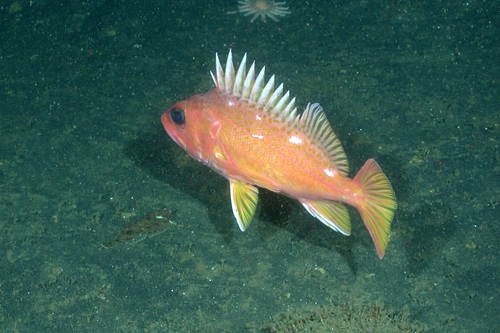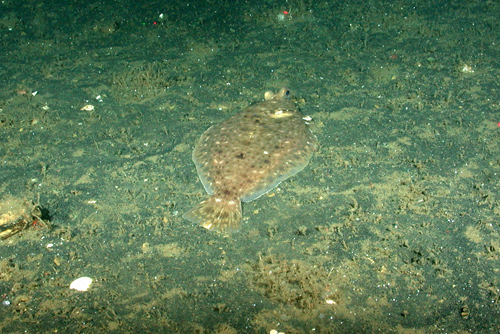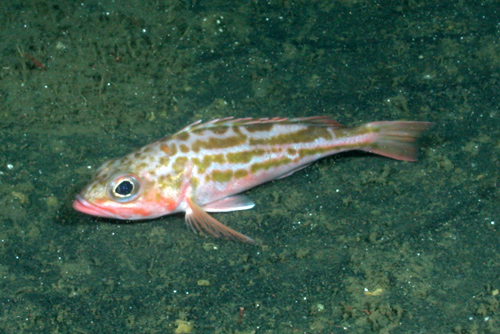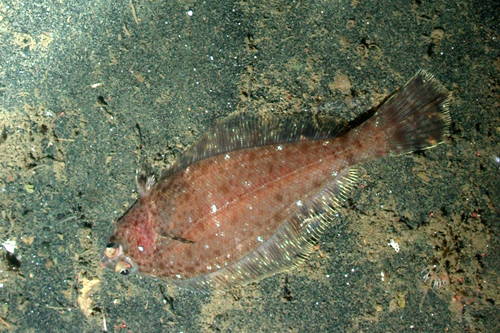Overview
Bodega Canyon is the most prominent submarine canyon within Cordell Bank National Marine Sanctuary. This seafloor feature, which is 20 km long and over 1600 m deep, cuts across the continental slope in the northwest portion of the sanctuary and extends to the deep sea.
Several small submarine canyons also cut into the continental slope of Cordell Bank National Marine Sanctuary. Present scientific knowledge about these canyons is limited as they are largely unexplored.
The majority of canyon habitat is expected to be soft-bottom, while a much smaller portion is predicted to be hard-bottom. Much of the sediment carried by alongshore currents ends up in the axes of active submarine canyons. For example, it is estimated that approximately 500,000 cubic meters (17,657,333 cubic feet) of sand as well as large volumes of finer-grained material descend into Monterey Canyon each year. Submarine landslides from canyon walls also deposit sediments on the canyon floor.
Submarine canyon sediment transport events are thought to be episodic. Potential triggering events include storms, earthquakes, moderate sea and surf conditions, tidal fluctuation, and flooding rivers. The frequency of these events is not well known. Current monitoring efforts, including repeat bathymetric mapping and installation of instruments in the canyons, enable scientists to determine locations where deposition and erosion take place and to quantify the frequency and intensity of sediment transport events. The organic material associated with sediments provides nutrients to deep-sea organisms.
Most organisms observed in canyons are not unique to canyon systems but are also found at similar depths outsides canyons. However, because submarine canyons extend from shallow waters of the continental shelf to the deep sea and contain a wide range of habitats, they contain an incredible diversity of organisms.
Mobile fishes and invertebrates, such as prickly sharks and krill, have been found to aggregate in canyon heads and along canyon walls. Rocky outcrops along canyon walls are colonized by invertebrates – including feather stars, corals and tunicates – and provide shelter for a variety of rockfishes. Clams and worms burrow into canyon walls. The soft sediments on the canyon floor support a diverse community of invertebrates (e.g., sea pens, sea cucumbers, brittle stars, sea stars) and fishes (e.g., flatfishes, ratfishes, whiptails, grenadiers, sablefish, hake, thornyheads).
Submarine canyons are vulnerable to a variety of human activities because they extend across a range of depths. A comparison of contaminant loads in surface and deep-sea fishes in Monterey Bay found elevated concentrations of persistent organic pollutants, such as PCBs and DDT, in fishes collected from the Monterey Submarine Canyon.
The risk of pollutant bioaccumulation is higher in submarine canyons than in surrounding waters because the flow of sediments and pollutants tends to be concentrated in canyons. These processes may also lead to an accumulation of marine debris, such as abandoned fishing gear, plastics and other man-made items, in canyons.
Photos
Maps
Elkhorn Slough, Moss Landing and Monterey Canyon
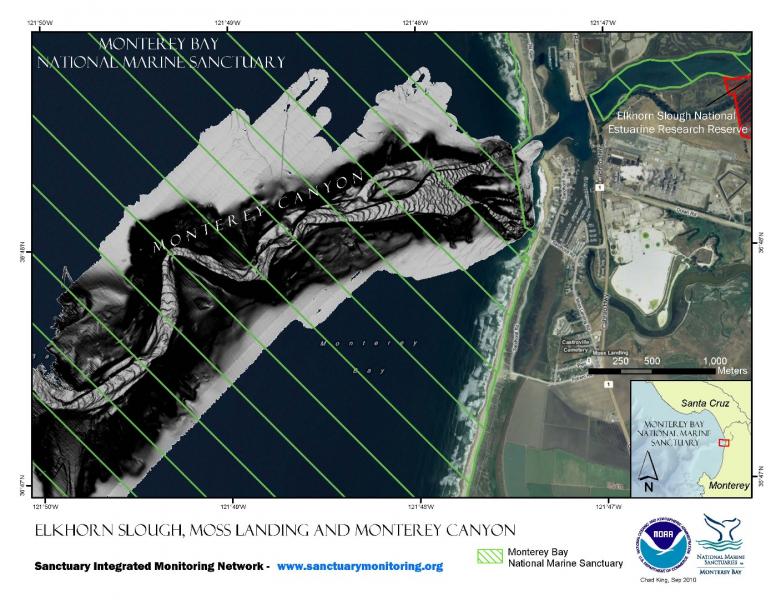
[View Larger]
Projects
Links
MBARI - Current Research Projects
Learn about current research projects conducted by the Monterey Bay Aquarium Research Institute (MBARI).http://www.mbari.org/rd/projects/current_projects.html
MBARI - Deep-Sea Guide
A web-based system that allows for the correlation of visual, descriptive, and observational data with environmental data from multiple sources by providing tools for searching, identifying, and examining occurrence data (e.g., depth, time, abundance) for biological, geological, and experimental observations.http://dsg.mbari.org/
MBARI - Mapping the Monterey Canyon
See how the Monterey Bay Aquarium Research Institute (MBARI) is involved in mapping the seafloor of the Monterey Bay National Marine Sanctuary.http://www.mbari.org/canyon/Mapping_Sections.htm
MBARI - Vessels and Vehicles
Take a closer look at some of the Monterey Bay Aquarium Research Institute's (MBARI) vessels and vehicles that allow scientists to get a closer look at the deep sea.http://www.mbari.org/data/images_video/vessels_vehicles.htm
MBNMS Teacher Curriculum - The Land-Sea Connection
Teacher activity "The Land-Sea Connection": Conducting a Transect Along the Seafloor of the Monterey Bay National Marine Sanctuary, takes students in for a close look at the Sanctuary's benthic region. After becoming familiar with a bathymetric/topographic map of the area, students select a transect along the seafloor to study some of the geological, biological, and physical features that are present. Available in both Spanish and English.http://montereybay.nos.noaa.gov/educate/teachercurriculum/investigation2.html
Monterey Bay Aquarium - Mission to the Deep
Learn more about the fascinating world of the deep sea.http://www.montereybayaquarium.org/efc/efc_mbari/mbari_home.aspx?bhcp=1
Monterey Bay Aquarium - Student and Teacher Resources and Activities
The Monterey Bay Aquarium offers teacher and student resources including: species and habitat-specific information, live cams, classroom activities, and interactive online games.http://www.mbayaq.org/lc/
National Geographic Society - Monterey Bay Sanctuary
Take a virtual dive into the kelp forest, or explore the submarine canyon in the Monterey Bay Sanctuary, one of the largest protected marine areas in the world.http://www.nationalgeographic.com/monterey/
National Geographic Society - Monterey Bay Sanctuary
Take a virtual dive into the kelp forest, or explore the submarine canyon in the Monterey Bay Sanctuary, one of the largest protected marine areas in the world.http://www.nationalgeographic.com/monterey/
NOAA - Ocean Exploration Lesson Plans
Students of all ages can learn about the oceans with near real-time access to a series of multidisciplinary deep ocean explorations. The site offers a set of over 100 hands-on and standards-based lesson plans for student exploration and discovery. Using new technological "eyes" to see, sense, measure, image, and describe a little known ocean world, these lessons bring the excitement of late-breaking ocean discoveries into classrooms.http://oceanexplorer.noaa.gov/explorations/06davidson/background/edu/lessonplans.html
UCSC Science Notes - AUV Dorado
Learn more about the Autonomous Underwater Vehicle (AUV) Dorado and its exciting capabilities in a University of California, Santa Cruz (UCSC) Science Notes online article.http://scicom.ucsc.edu/SciNotes/0201/lo/sub/
USGS - Monterey Bay Internet Map Server
Continental Shelf GIS for the Monterey Bay Area - selected data layers for the USGS seafloor for the Monterey Bay National Marine Sanctuary Project from USGS published reports and other sources.http://coastalmap.marine.usgs.gov/ArcIMS/website/usa/westcoast/cencal/montereybay/viewer.htm
USGS Pacific Coastal & Marine Science Center
Homepage of USGS Division that conducts multidisciplinary scientific research in the coastal and offshore areas of California, Oregon, Washington, Alaska, Hawaii, and other US Pacific Islands; and in other waterways of the United States.http://walrus.wr.usgs.gov
Virtual Descent into Monterey Submarine Canyon
Take a trip into the depths of the ocean and explore a place that scientists are just now beginning to study in great detail. During this presentation, you will be able to listen and read about each photograph in both English and Spanish!http://projects.edtech.sandi.net/projects/descent/Descent01.html
